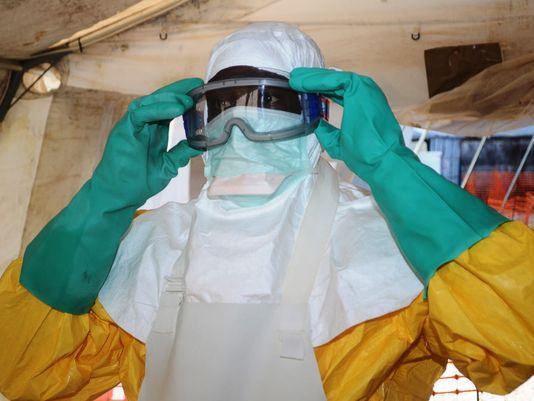World and U.S. health officials urge airline crews to isolate passengers who show symptoms of Ebola if they have recently traveled to West African countries suffering an outbreak of the deadly disease.

A member of Doctors Without Borders puts on protective gear June 28 at the isolation ward of the Donka Hospital in Conakry, where people infected with the Ebola virus are being treated. The World Health Organization has warned that Ebola could spread beyond hard-hit Guinea, Liberia and Sierra Leone to neighboring countries.
(Photo: CELLOU BINANI, AFP/Getty Images)
But the World Health Organization isn’t recommending screening airline passengers leaving the region of Guinea, Liberia or Sierra Leone. Screening is costly and detected few cases after an outbreak in 2003 of Severe Acute Respiratory Syndrome, or SARS, that began in China.
Sick people are urged not to travel. Because Ebola’s incubation period is two to 21 days and early symptoms aren’t specific, using thermal scanners to detect fevers is costly, unlikely to detect anyone infected with Ebola “and is not encouraged,” according to the WHO
Health officials are monitoring the worst Ebola outbreak in history in consultation with the International Air Transport Association, which represents 240 airlines worldwide, and the International Civil Aviation Organization, a branch of the United Nations that sets policies.
“Discussions are currently being held regarding travel and trade,” said Leticia Linn, a WHO spokeswoman, and an update “will likely come next week.”
The Ebola outbreak has killed more than 700 people in West Africa and infected more than 1,300, according to the WHO.
Tom Frieden, director of the U.S. Centers for Disease Control and Prevention, estimated the outbreak will take three to six months to contain under the best of circumstances. He said the risk to people in the USA is small among the 10,000 travelers from the region expected over a three-month period.
“Ebola poses little risk to the U.S. general population,” Frieden said. “The number of travelers from these countries to the U.S. is relatively small.”
Ebola is spread through close contact, typically through direct contact with the blood, saliva or urine of an infected person, according to the CDC.
Early symptoms include fever, chills, muscle aches and jaundice. If a passenger exhibits symptoms after living or traveling in an area where Ebola is present, the CDC recommends an evaluation by a health care provider.
Later symptoms include nausea, vomiting, chest pain, sore throat, abdominal pain and diarrhea. Symptoms become increasingly severe and may include severe weight loss, shock and organ failure.
The captain of a plane bound for the USA is required to report to the CDC before arrival any deaths onboard or any ill travelers who meet the Ebola description. Two dozen U.S. airports that handle the bulk of international flights each have quarantine locations where sick travelers can be evaluated.
“We have at CDC quarantine stations in all of the major ports of entry,” Frieden said. “If a patient is ill on a plane, we are called to assess, and if appropriate, we would undertake tracking or tracing of the people around that individual on the plane.”
If Ebola is suspected in an airline passenger or crewmember, the CDC suggestions include:
•Keeping the person separated from others.
•Providing the person with a surgical mask to reduce fluids expelled from talking, sneezing or coughing.
•Wearing impermeable gloves.
For airline cleaning crews on a flight with an Ebola patient, CDC suggestions include:
•Wearing impermeable gloves to clean the passenger cabin and lavatories.
•Wiping down bathroom surfaces and other frequently touched places with a chemical germicide registered with the Environmental Protection Agency.
•Avoiding the use of compressed air, which could spread infectious materials.
•Removing and discarding any seat covers soiled with fluids.
•Cleaning hands with soap and water or an alcohol-based sanitizer after gloves are removed.
During the SARS outbreak in 2003, the WHO recommended screening passengers with questionnaires and thermal scanners, but few sick travelers were detected.
Hong Kong screened 36 million passengers and detected two cases, and Australia screened 1.8 million people arriving, and four cases were detected by border screening, according to a 2005 study by K. Glass and N.G. Becker.
Canada screened 4 million passengers and detected no cases, and Singapore screened 400,000 people entering the country and detected no cases, according to the study.
“The challenge for travel screening is that there is an ‘incubation’ period between someone being infected until they start showing symptoms,” said Kathryn Glass, a fellow at Australian National University who co-authored the SARS report. “If infected people travel during that time, they are hard to spot based on symptoms. For diseases like influenza and SARS, we have the additional problem that early symptoms can be difficult to distinguish from many other conditions.”





